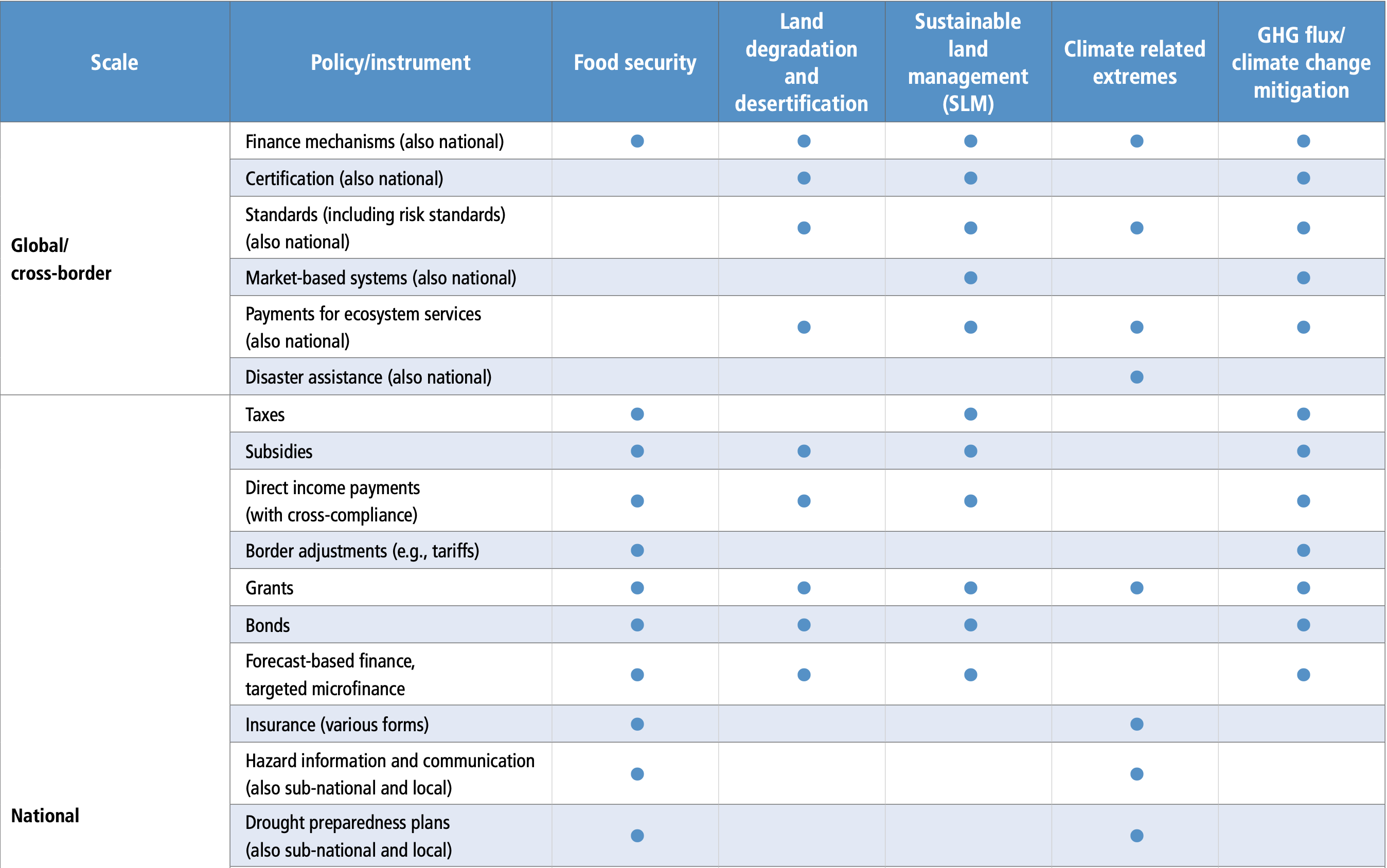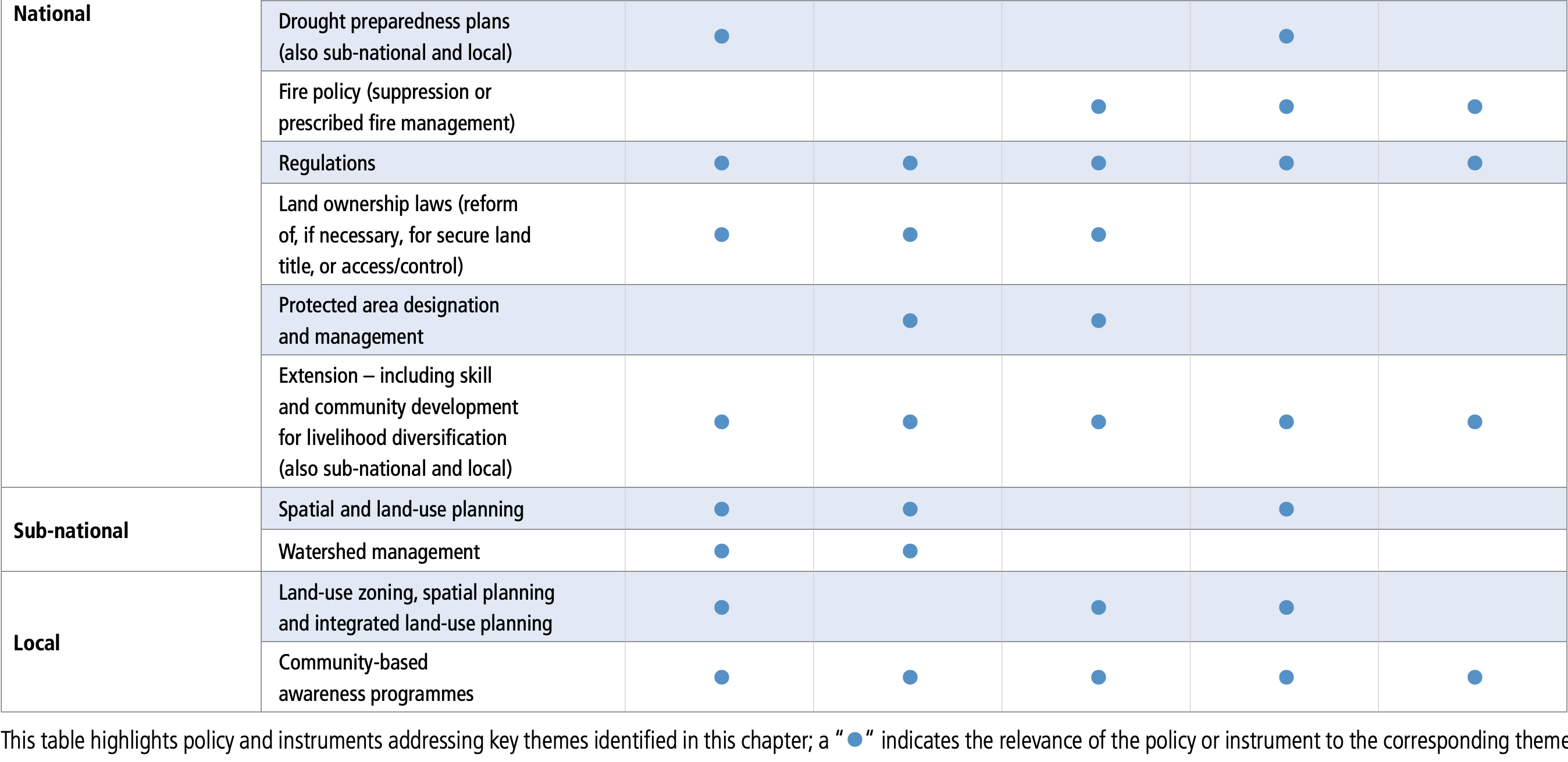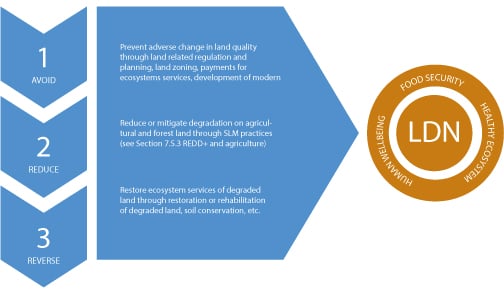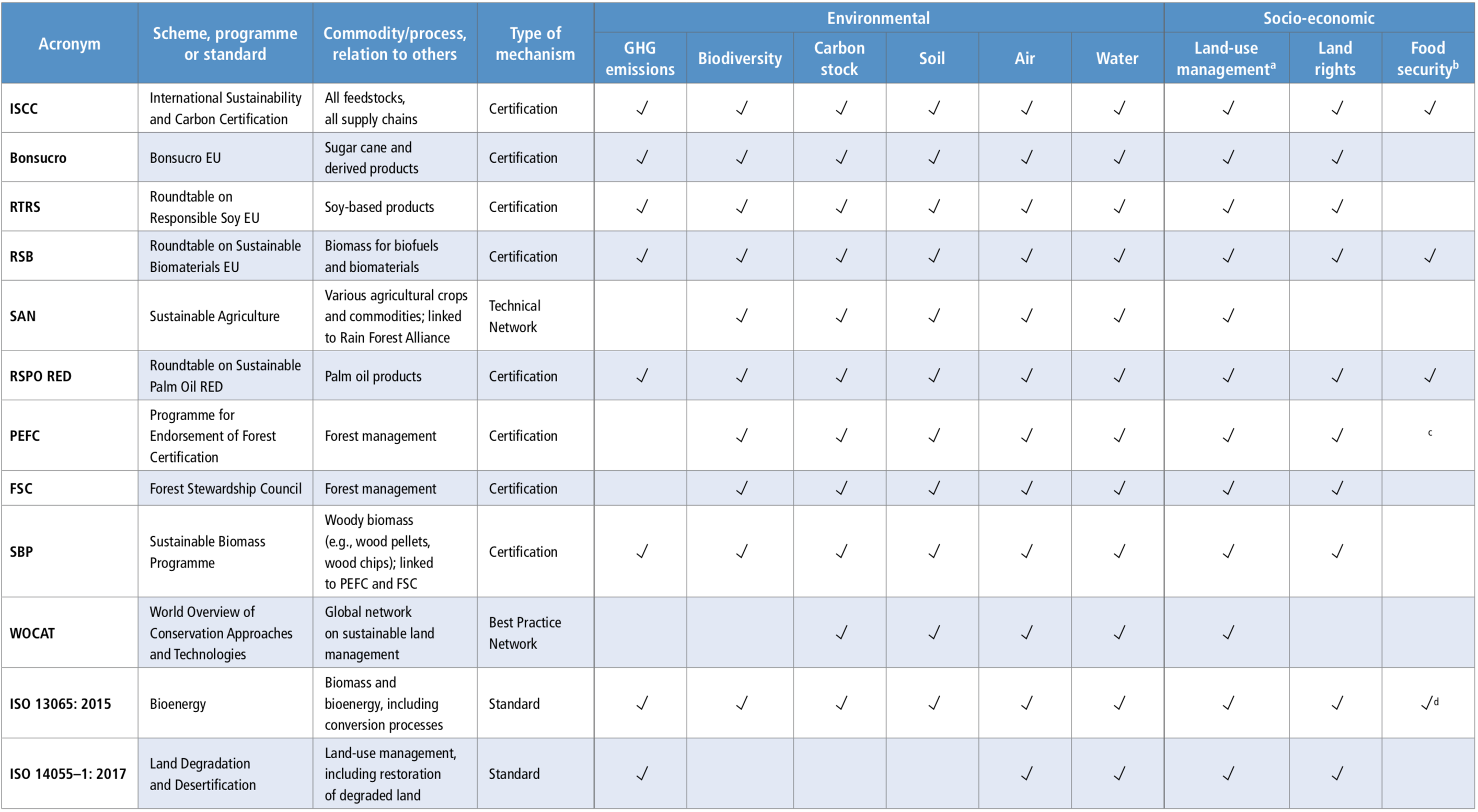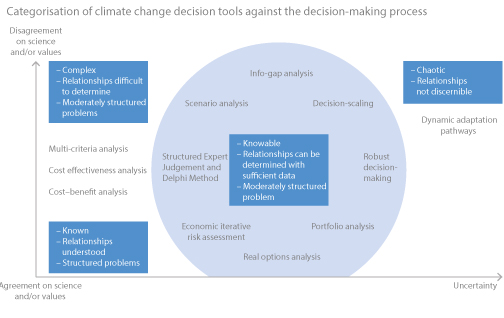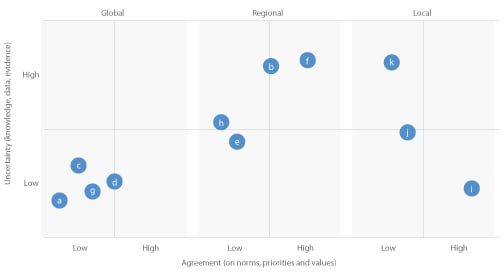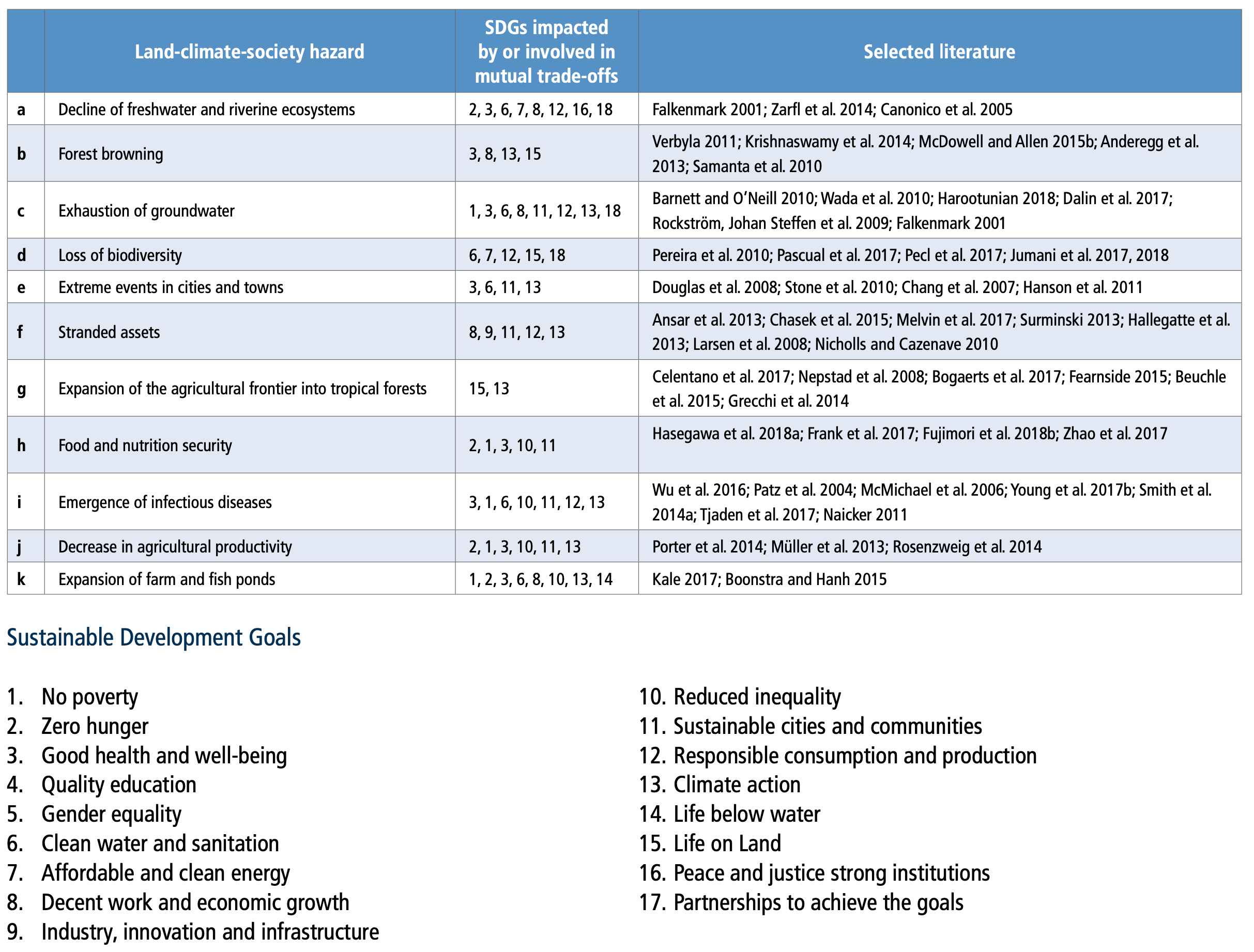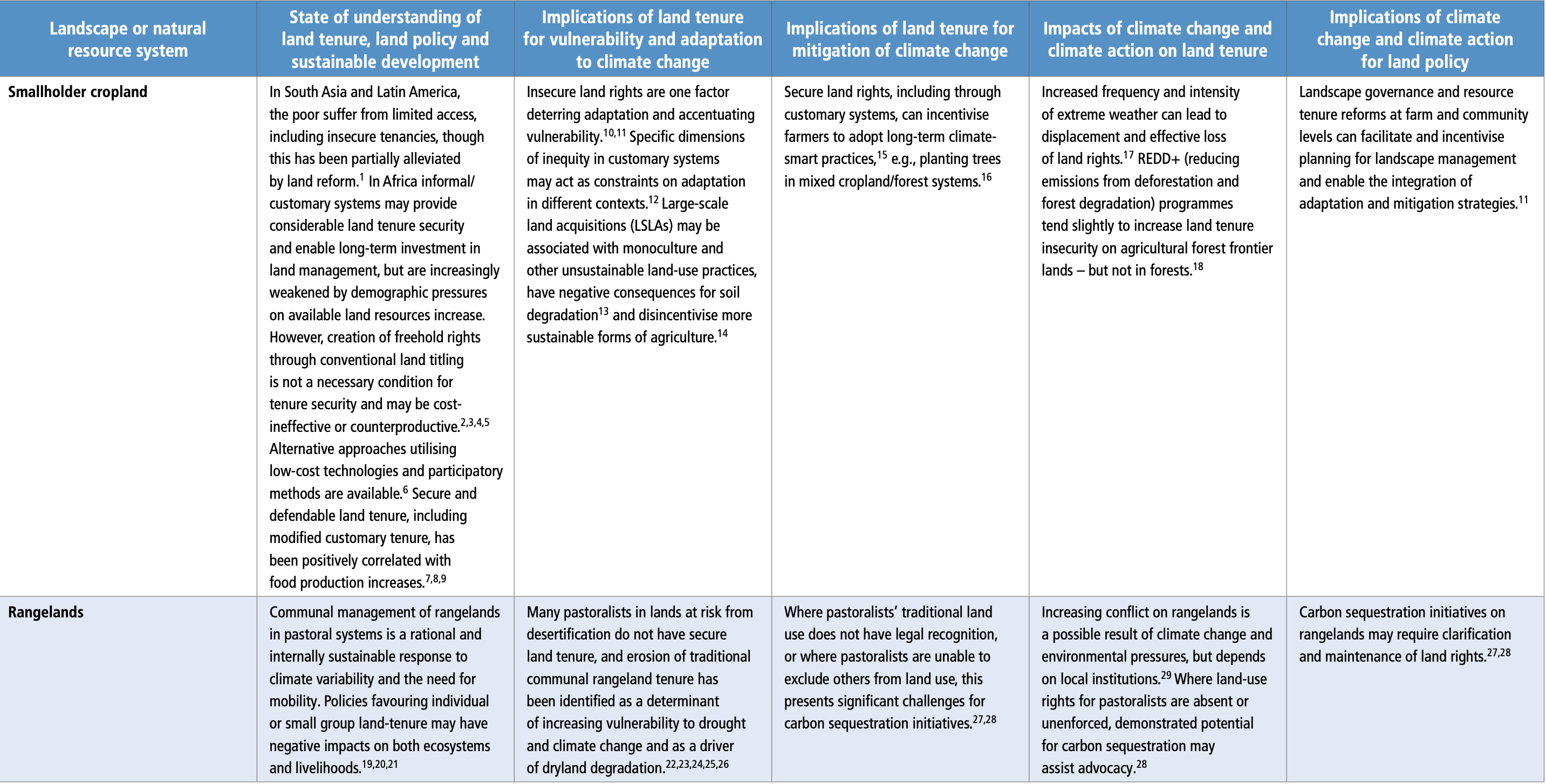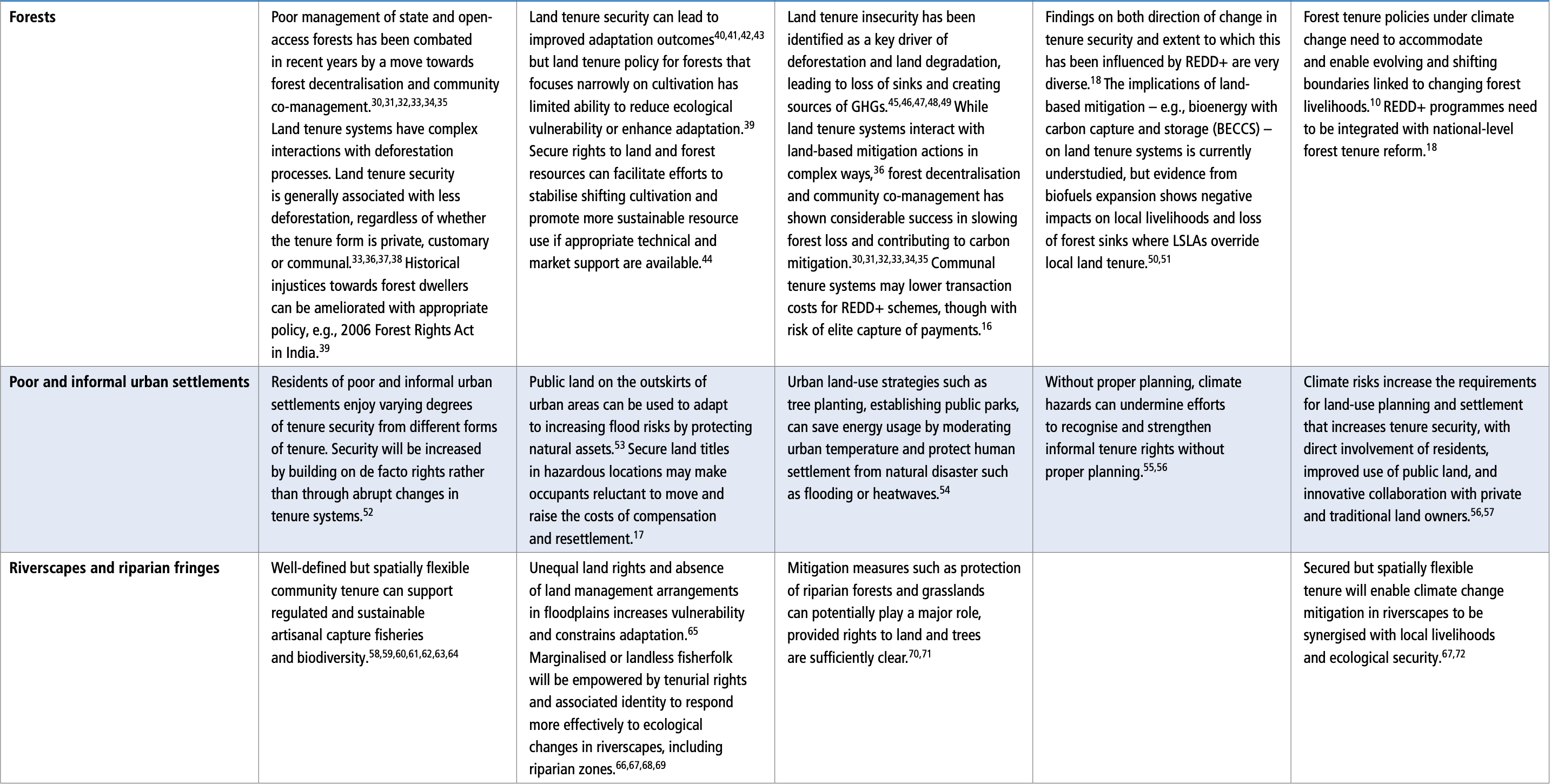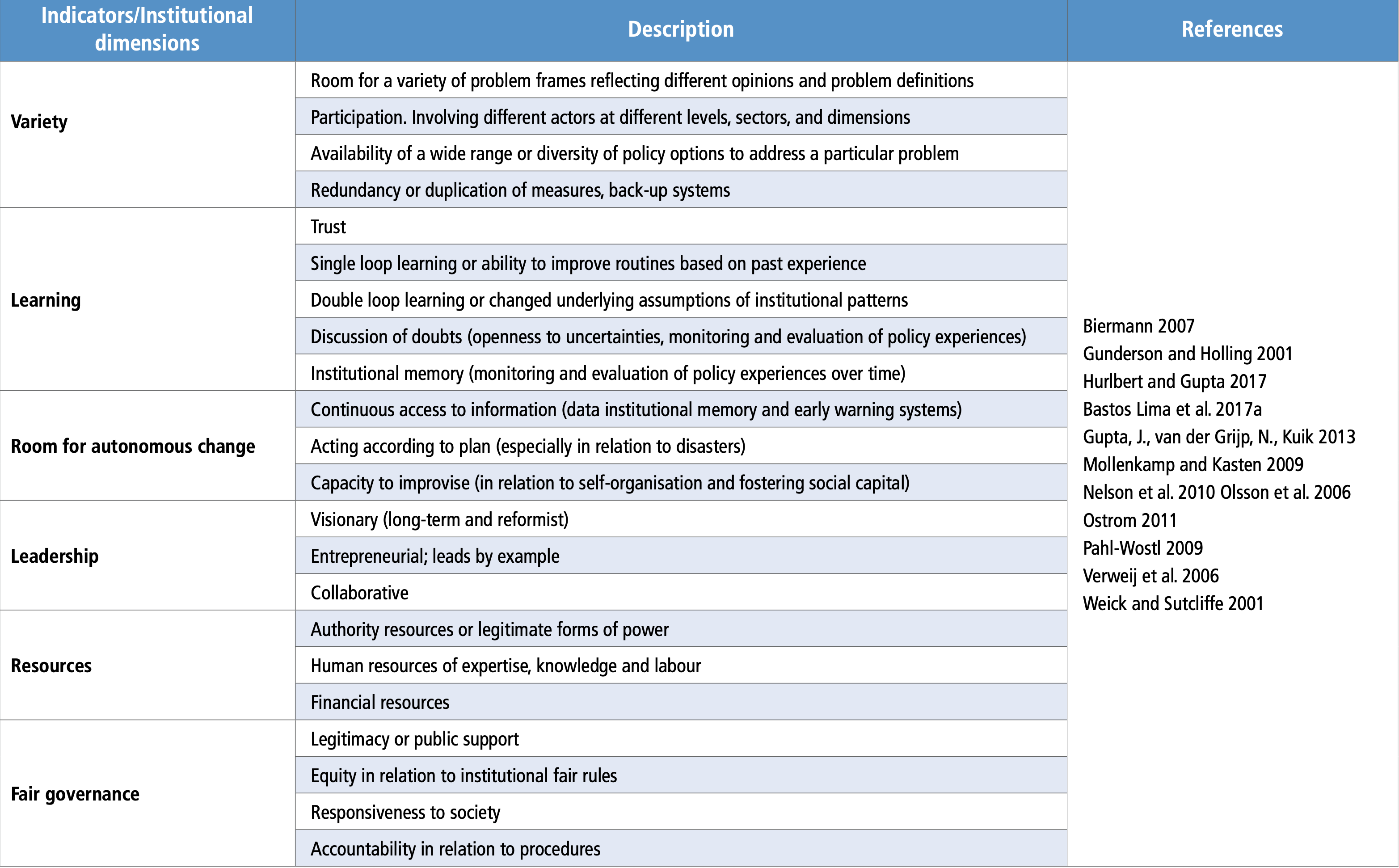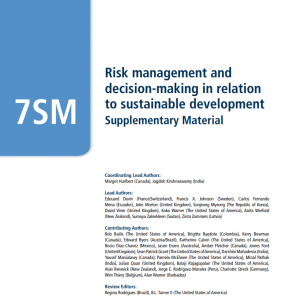ES
Executive summary
Increases in global mean surface temperature are projected to result in continued permafrost degradation and coastal degradation (high confidence), increased wildfire, decreased crop yields in low latitudes, decreased food stability, decreased water availability, vegetation loss (medium confidence), decreased access to food and increased soil erosion (low confidence). There is high agreement and high evidence that increases in global mean temperature will result in continued increase in global vegetation loss, coastal degradation, as well as decreased crop yields in low latitudes, decreased food stability, decreased access to food and nutrition, and medium confidence in continued permafrost degradation and water scarcity in drylands. Impacts are already observed across all components (high confidence). Some processes may experience irreversible impacts at lower levels of warming than others. There are high risks from permafrost degradation, and wildfire, coastal degradation, stability of food systems at 1.5°C while high risks from soil erosion, vegetation loss and changes in nutrition only occur at higher temperature thresholds due to increased possibility for adaptation (medium confidence). {7.2.2.1, 7.2.2.2, 7.2.2.3; 7.2.2.4; 7.2.2.5; 7.2.2.6; 7.2.2.7; Figure 7.1}
These changes result in compound risks to food systems, human and ecosystem health, livelihoods, the viability of infrastructure, and the value of land (high confidence). The experience and dynamics of risk change over time as a result of both human and natural processes (high confidence). There is high confidence that climate and land changes pose increased risks at certain periods of life (i.e., to the very young and ageing populations) as well as sustained risk to those living in poverty. Response options may also increase risks. For example, domestic efforts to insulate populations from food price spikes associated with climatic stressors in the mid-2000s inadequately prevented food insecurity and poverty, and worsened poverty globally. {7.2.1, 7.2.2, 7.3, Table 7.1}
There is significant regional heterogeneity in risks: tropical regions, including Sub-Saharan Africa, Southeast Asia and Central and South America are particularly vulnerable to decreases in crop yield (high confidence). Yield of crops in higher latitudes may initially benefit from warming as well as from higher carbon dioxide (CO2) concentrations. But temperate zones, including the Mediterranean, North Africa, the Gobi desert, Korea and western United States are susceptible to disruptions from increased drought frequency and intensity, dust storms and fires (high confidence). {7.2.2}
Risks related to land degradation, desertification and food security increase with temperature and can reverse development gains in some socio-economic development pathways (high confidence). SSP1 reduces the vulnerability and exposure of human and natural systems and thus limits risks resulting from desertification, land degradation and food insecurity compared to SSP3 (high confidence). SSP1 is characterised by low population growth, reduced inequalities, land-use regulation, low meat consumption, increased trade and few barriers to adaptation or mitigation. SSP3 has the opposite characteristics. Under SSP1, only a small fraction of the dryland population (around 3% at 3°C for the year 2050) will be exposed and vulnerable to water stress. However under SSP3, around 20% of dryland populations (for the year 2050) will be exposed and vulnerable to water stress by 1.5°C and 24% by 3°C. Similarly under SSP1, at 1.5°C, 2 million people are expected to be exposed and vulnerable to crop yield change. Over 20 million are exposed and vulnerable to crop yield change in SSP3, increasing to 854 million people at 3°C (low confidence). Livelihoods deteriorate as a result of these impacts, livelihood migration is accelerated, and strife and conflict is worsened (medium confidence). {Cross-Chapter Box 9 in Chapters 6 and 7, 7.2.2, 7.3.2, Table 7.1, Figure 7.2}
Land-based adaptation and mitigation responses pose risks associated with the effectiveness and potential adverse side-effects of measures chosen (medium confidence). Adverse side-effects on food security, ecosystem services and water security increase with the scale of bioenergy and bioenergy with carbon capture and storage (BECCS) deployment. In a SSP1 future, bioenergy and BECCS deployment up to 4 million km2 is compatible with sustainability constraints, whereas risks are already high in a SSP3 future for this scale of deployment. {7.2.3}
There is high confidence that policies addressing vicious cycles of poverty, land degradation and greenhouse gas (GHG) emissions implemented in a holistic manner can achieve climate-resilient sustainable development. Choice and implementation of policy instruments determine future climate and land pathways (medium confidence). Sustainable development pathways (described in SSP1) supported by effective regulation of land use to reduce environmental trade-offs, reduced reliance on traditional biomass, low growth in consumption and limited meat diets, moderate international trade with connected regional markets, and effective GHG mitigation instruments) can result in lower food prices, fewer people affected by floods and other climatic disruptions, and increases in forested land (high agreement, limited evidence) (SSP1). A policy pathway with limited regulation of land use, low technology development, resource intensive consumption, constrained trade, and ineffective GHG mitigation instruments can result in food price increases, and significant loss of forest (high agreement, limited evidence) (SSP3). {3.7.5, 7.2.2, 7.3.4, 7.5.5, 7.5.6, Table 7.1, Cross-Chapter Box 9 in Chapters 6 and 7, Cross-Chapter Box 12 in Chapter 7}
Delaying deep mitigation in other sectors and shifting the burden to the land sector, increases the risk associated with adverse effects on food security and ecosystem services (high confidence). The consequences are an increased pressure on land with higher risk of mitigation failure and of temperature overshoot and a transfer of the burden of mitigation and unabated climate change to future generations. Prioritising early decarbonisation with minimal reliance on carbon dioxide removal (CDR) decreases the risk of mitigation failure (high confidence). {2.5, 6.2, 6.4, 7.2.1, 7.2.2, 7.2.3, 7.5.6, 7.5.7, Cross-Chapter Box 9 in Chapters 6 and 7}
Trade-offs can occur between using land for climate mitigation or Sustainable Development Goal (SDG) 7 (affordable clean energy) with biodiversity, food, groundwater and riverine ecosystem services (medium confidence). There is medium confidence that trade-offs currently do not figure into climate policies and decision making. Small hydro power installations (especially in clusters) can impact downstream river ecological connectivity for fish (high agreement, medium evidence). Large scale solar farms and wind turbine installations can impact endangered species and disrupt habitat connectivity (medium agreement, medium evidence). Conversion of rivers for transportation can disrupt fisheries and endangered species (through dredging and traffic) (medium agreement, low evidence). {7.5.6}
The full mitigation potential assessed in this report will only be realised if agricultural emissions are included in mainstream climate policy (high agreement, high evidence). Carbon markets are theoretically more cost-effective than taxation but challenging to implement in the land-sector (high confidence) Carbon pricing (through carbon markets or carbon taxes) has the potential to be an effective mechanism to reduce GHG emissions, although it remains relatively untested in agriculture and food systems. Equity considerations can be balanced by a mix of both market and non-market mechanisms (medium evidence, medium agreement). Emissions leakage could be reduced by multi-lateral action (high agreement, medium evidence). {7.4.6, 7.5.5, 7.5.6, Cross-Chapter Box 9 in Chapters 6 and 7}
A suite of coherent climate and land policies advances the goal of the Paris Agreement and the land-related SDG targets on poverty, hunger, health, sustainable cities and communities, responsible consumption and production, and life on land. There is high confidence that acting early will avert or minimise risks, reduce losses and generate returns on investment. The economic costs of action on sustainable land management (SLM), mitigation, and adaptation are less than the consequences of inaction for humans and ecosystems (medium confidence). Policy portfolios that make ecological restoration more attractive, people more resilient – expanding financial inclusion, flexible carbon credits, disaster risk and health insurance, social protection and adaptive safety nets, contingent finance and reserve funds, and universal access to early warning systems – could save 100 billion USD a year, if implemented globally. {7.3.1, 7.4.7, 7.4.8, 7.5.6, Cross-Chapter Box 10 in Chapter 7}
Coordination of policy instruments across scales, levels, and sectors advances co-benefits, manages land and climate risks, advances food security, and addresses equity concerns (medium confidence). Flood resilience policies are mutually reinforcing and include flood zone mapping, financial incentives to move, and building restrictions, and insurance. Sustainability certification, technology transfer, land-use standards and secure land tenure schemes, integrated with early action and preparedness, advance response options. SLM improves with investment in agricultural research, environmental farm practices, agri-environmental payments, financial support for sustainable agricultural water infrastructure (including dugouts), agriculture emission trading, and elimination of agricultural subsidies (medium confidence). Drought resilience policies (including drought preparedness planning, early warning and monitoring, improving water use efficiency), synergistically improve agricultural producer livelihoods and foster SLM. {3.7.5, Cross-Chapter Box 5 in Chapter 3, 7.4.3, 7.4.6, 7.5.6, 7.4.8, , 7.5.6, 7.6.3}
Technology transfer in land-use sectors offers new opportunities for adaptation, mitigation, international cooperation, R&D collaboration, and local engagement (medium confidence). International cooperation to modernise the traditional biomass sector will free up both land and labour for more productive uses. Technology transfer can assist the measurement and accounting of emission reductions by developing countries. {7.4.4, 7.4.6, Cross-Chapter Box 12 in Chapter 7}
Measuring progress towards goals is important in decision-making and adaptive governance to create common understanding and advance policy effectiveness (high agreement, medium evidence). Measurable indicators, selected with the participation of people and supporting data collection, are useful for climate policy development and decision-making. Indicators include the SDGs, nationally determined contributions (NDCs), land degradation neutrality (LDN) core indicators, carbon stock measurement, measurement and monitoring for REDD+, metrics for measuring biodiversity and ecosystem services, and governance capacity. {7.5.5, 7.5.7, 7.6.4, 7.6.6}
The complex spatial, cultural and temporal dynamics of risk and uncertainty in relation to land and climate interactions and food security, require a flexible, adaptive, iterative approach to assessing risks, revising decisions and policy instruments (high confidence). Adaptive, iterative decision making moves beyond standard economic appraisal techniques to new methods such as dynamic adaptation pathways with risks identified by trigger points through indicators. Scenarios can provide valuable information at all planning stages in relation to land, climate and food; adaptive management addresses uncertainty in scenario planning with pathway choices made and reassessed to respond to new information and data as it becomes available. {3.7.5, 7.4.4, 7.5.2, 7.5.3, 7.5.4, 7.5.7, 7.6.1, 7.6.3}
Indigenous and local knowledge (ILK) can play a key role in understanding climate processes and impacts, adaptation to climate change, sustainable land management (SLM) across different ecosystems, and enhancement of food security (high confidence). ILK is context-specific, collective, informally transmitted, and multi-functional, and can encompass factual information about the environment and guidance on management of resources and related rights and social behaviour. ILK can be used in decision-making at various scales and levels, and exchange of experiences with adaptation and mitigation that include ILK is both a requirement and an entry strategy for participatory climate communication and action. Opportunities exist for integration of ILK with scientific knowledge. {7.4.1, 7.4.5, 7.4.6, 7.6.4, Cross-Chapter Box 13 in Chapter 7}
Participation of people in land and climate decision making and policy formation allows for transparent effective solutions and the implementation of response options that advance synergies, reduce trade-offs in SLM (medium confidence), and overcomes barriers to adaptation and mitigation (high confidence). Improvements to SLM are achieved by: (i) engaging people in citizen science by mediating and facilitating landscape conservation planning, policy choice, and early warning systems (medium confidence); (ii) involving people in identifying problems (including species decline, habitat loss, land-use change in agriculture, food production and forestry), selection of indicators, collection of climate data, land modelling, agricultural innovation opportunities. When social learning is combined with collective action, transformative change can occur addressing tenure issues and changing land-use practices (medium confidence). Meaningful participation overcomes barriers by opening up policy and science surrounding climate and land decisions to inclusive discussion that promotes alternatives. {3.7.5, 7.4.1, 7.4.9; 7.5.1, 7.5.4, 7.5.5, 7.5.7, 7.6.4, 7.6.6}
Empowering women can bolster synergies among household food security and SLM (high confidence). This can be achieved with policy instruments that account for gender differences. The overwhelming presence of women in many land based activities including agriculture provides opportunities to mainstream gender policies, overcome gender barriers, enhance gender equality, and increase SLM and food security (high confidence). Policies that address barriers include gender qualifying criteria and gender appropriate delivery, including access to financing, information, technology, government transfers, training, and extension may be built into existing women’s programmes, structures (civil society groups) including collective micro enterprise (medium confidence). {Cross-Chapter Box 11 in Chapter 7}
The significant social and political changes required for sustainable land use, reductions in demand and land-based mitigation efforts associated with climate stabilisation require a wide range of governance mechanisms. The expansion and diversification of land use and biomass systems and markets requires hybrid governance: public-private partnerships, transnational, polycentric, and state governance to insure opportunities are maximised, trade-offs are managed equitably and negative impacts are minimised (medium confidence). {7.4.6, 7.6.2, 7.6.3, Cross-Chapter Box 7 in Chapter 6}
Land tenure systems have implications for both adaptation and mitigation, which need to be understood within specific socio-economic and legal contexts, and may themselves be impacted by climate change and climate action (limited evidence, high agreement). Land policy (in a diversity of forms beyond focus on freehold title) can provide routes to land security and facilitate or constrain climate action, across cropping, rangeland, forest, freshwater ecosystems and other systems. Large-scale land acquisitions are an important context for the relations between tenure security and climate change, but their scale, nature and implications are imperfectly understood. There is medium confidence that land titling and recognition programmes, particularly those that authorize and respect indigenous and communal tenure, can lead to improved management of forests, including for carbon storage. Strong public coordination (government and public administration) can integrate land policy with national policies on adaptation and reduce sensitivities to climate change. {7.6.2; 7.6.3; 7.6.4, 7.6.5}
Significant gaps in knowledge exist when it comes to understanding the effectiveness of policy instruments and institutions related to land-use management, forestry, agriculture and bioenergy. Interdisciplinary research is needed on the impacts of policies and measures in land sectors. Knowledge gaps are due in part to the highly contextual and local nature of land and climate measures and the long time periods needed to evaluate land-use change in its socio-economic frame, as compared to technological investments in energy or industry that are somewhat more comparable. Significant investment is needed in monitoring, evaluation and assessment of policy impacts across different sectors and levels. {7.7}



